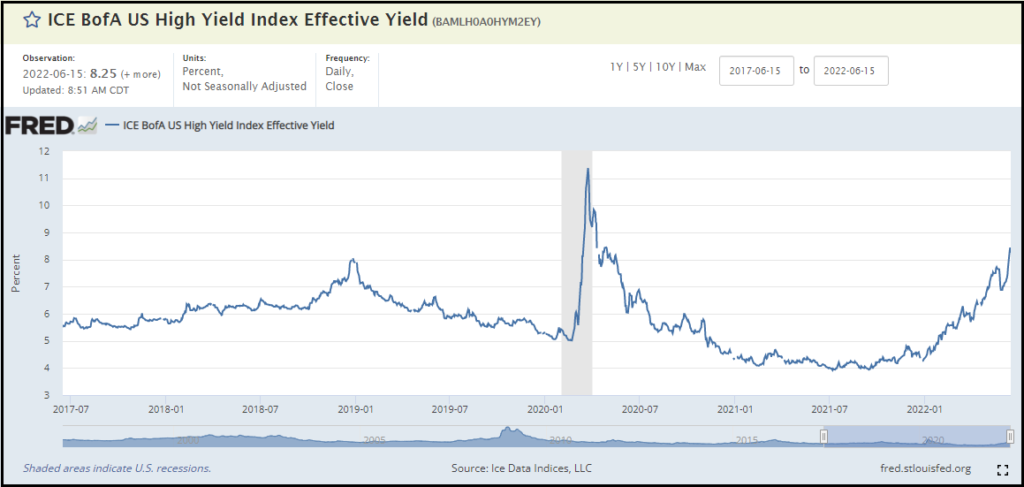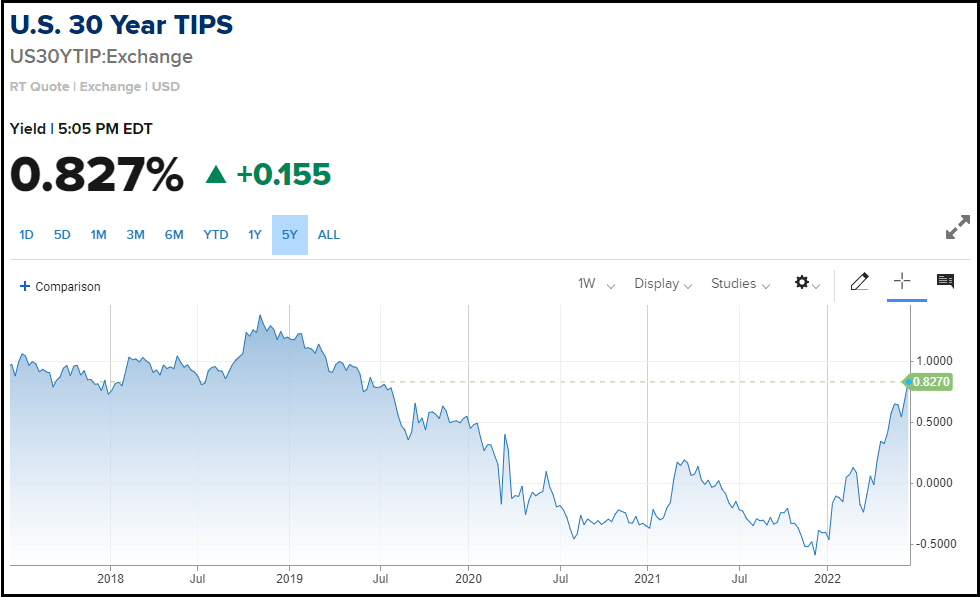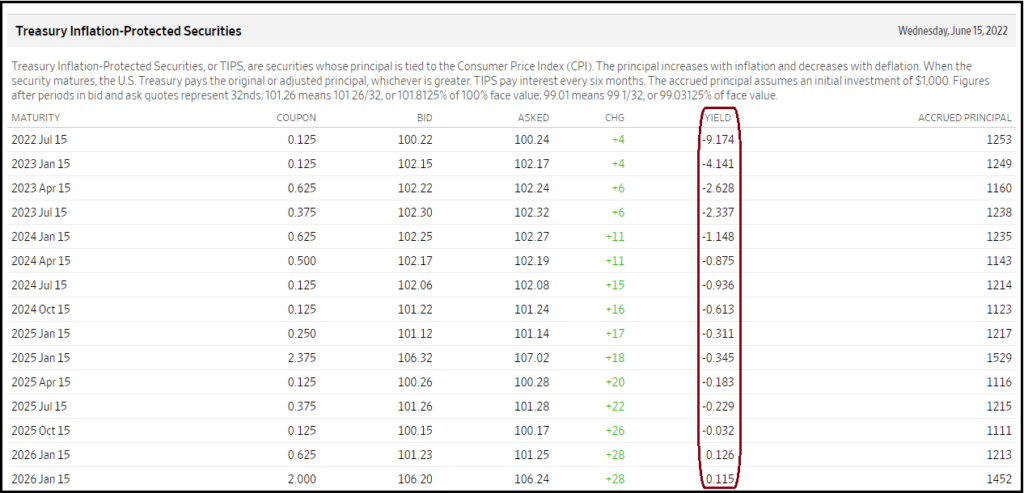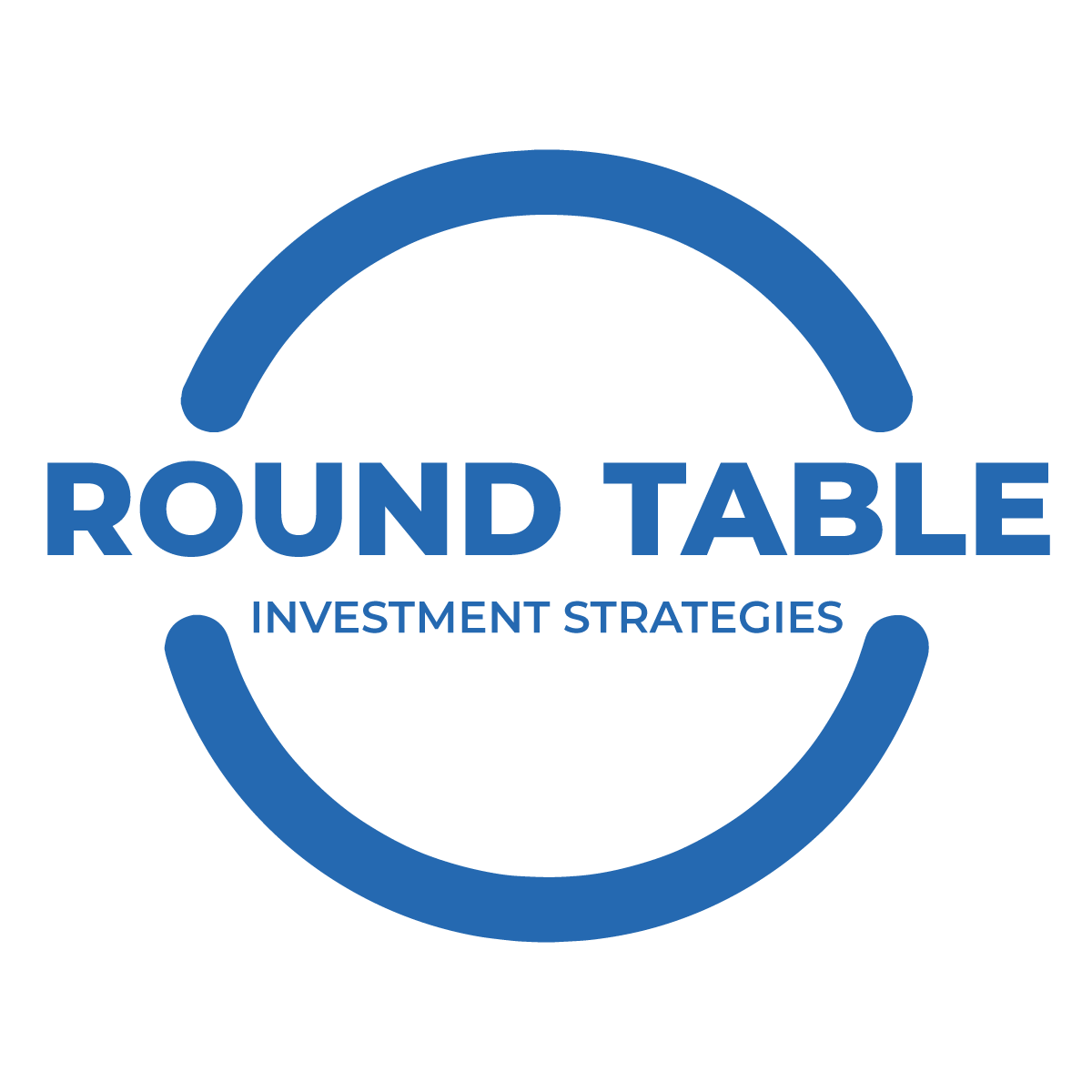I-Bonds article series:
- I-Bonds (you know, like how “Star Wars” is the first installment[1] of the “Star Wars” series)
- Are I-Bonds the Fabled “Free Lunch”?
- I-Bonds vs. TIPS: Compare and Contrast
(Lots of details below…or you can skip to the summary.)
Introduction
In our previous post, we pointed out that Series I Savings Bonds (“I-Bonds”) are currently paying a government-guaranteed 9.62% annualized interest rate, with no risk of loss to your principal. We noted how much higher a return that is than the FDIC-insured rates you can get in a savings account or CD. Indeed, based on a highly scientific poll of a few random people we asked,[2] most savings accounts are still paying out at a fraction of a percent.
But one need hardly stop at savings accounts to see the relative appeal of I-Bonds. Granted, interest rates have risen across the board in 2022. But even high yield bonds (a.k.a., junk bonds) are currently offering an average effective yield of a little over 8%, more than 1% less than I-Bonds.

Additionally, much of that 8% comes in the form of a “credit premium”—i.e., a higher yield demanded by the markets due to the issuing companies’ lesser creditworthiness, such that some junk bond issuers may fail to pay you back at all. And even without any defaults, your principal value in high yield bonds could decline, which has happened this year.[3] I-Bond yields on the other hand (A) are guaranteed by the U.S. government and (B) involve no risk to your principal.
Wait, less risk and higher returns?! To all appearances, we inaugurated Round Table’s blog by offering a tip on a “free lunch” for your investment dollars.[4] But based on blog posts we haven’t written yet, but that those who know our investment philosophy will realize are coming, there shouldn’t be any such thing as a free lunch in investing,[5] or at least it should be so hard to find that you’re generally better off “paying” for your “lunch” by accepting market risk to get market returns.
So are I-Bonds really an exception to the no-free-lunch rule? If so, how can that be? Let’s dig in…
In addition to I-Bonds, the U.S. Treasury offers another kind of inflation-protected bond called Treasury Inflation Protected Securities, or TIPS. In a third post in this series, we’ll compare and contrast various features of I-Bonds and TIPS, but a few key differences are important here.
First, I-Bonds can be held between one year and thirty years, and then redeemed for principal plus accrued interest (minus the last three months’ interest if the I-Bonds have been held for less than five years). TIPS, on the other hand, like other government or corporate bonds, have a prespecified maturity, ranging from less than a year (for off-the-run TIPS that are nearing their maturity date) to 30 years. You can buy or sell a TIPS instrument at any time, but its market value is constantly changing, and your return is only risk-free—in the sense of a government-guaranteed outcome—if you hold it to its maturity date.
I-Bonds vs. TIPS: Long-Term Comparison
If you bought a 30-year TIPS bond as of this writing, you would lock in a real (i.e., before inflation adjustments) yield to maturity of about 0.9%. So if you held the bond for the full 30 years, your investment will have grown by 30 years’ worth of inflation, plus another 0.9%/year for good measure.[6] If instead you purchased I-Bonds today, you would lock in a real rate of 0%—that’s the 0% “fixed rate” we mentioned in our prior post, on top of which I-Bonds are currently paying a 9%+ inflation rate.

In other words, in the absence of tax considerations, if you’re sure you want to hold for the long term, locking in long-term inflation protection, you would be slightly better off buying TIPS than buying I-Bonds. However, along the way, a 30-years TIPS instrument’s resale value can vary wildly, especially in the early years, whereas I-Bonds can always be redeemed for principal plus accrued (inflation-tracking) interest.[7] Whether that extra 0.9% is worth the wilder ride along the way is a matter of preference, but I-Bonds don’t immediately resemble a free lunch for the long-term.
If you’re deploying taxable investment dollars, I-Bonds have another big advantage: The interest accruals on I-Bonds are not taxable until you redeem (30 years in this example), whereas both the coupon payments and the inflation adjustments to face value (so-called “phantom income”[8]) on TIPS are taxable in the year they accrue[9]—potentially a big deal when inflation is running hot! As we seek to apprehend a free lunch, this looks a bit more like a smoking…um…tuna.
I-Bonds vs. TIPS: Short-Term Comparison
On the plus side, short-term TIPS have much less of the pesky risk to principal that you get with long-term TIPS in the years before maturity. But that nicety comes at a cost, certainly at present. As of this writing, buying short-term TIPS instruments on the open market will net you a real (i.e., pre-inflation) yield of anywhere from minus 2.3% (for one-year-ish TIPS) to minus 9.2% (for one-month-ish TIPS). Suddenly that 0% “fixed rate” on I-Bonds looks mighty attractive![10]

In fact, TIPS rates (again, real rates; i.e., before they add inflation) are currently negative out to about 3.5 years; not long ago they were negative even out to 30 years! And yet the fixed rate for I-Bonds never drops below 0%, because that is how I-Bonds are designed.
And that’s the key: TIPS are marketable securities, and the market will set fair prices for them, eliminating any free lunch, even if it means driving real yields into significantly negative territory. I-Bonds, on the other hand, are not priced by the market; they are a direct contract between the buyer and the U.S. Treasury, which guarantees a non-negative real return. Thus, to the extent the 0% fixed rate represents a “free lunch” at present, it comes from the same source as many actual free lunches: government subsidy.
Whether this design feature represents intentional government largesse is questionable. I wasn’t in the room when the final design of I-Bonds was fleshed out,[11] but I wouldn’t be shocked if the present combination of high inflation and low nominal[12] (i.e., normal, non-inflation-adjusted) bond yields—the formula for strongly negative real yields—wasn’t contemplated, or at least wasn’t deemed a major risk.
Importantly, this can go the other way: If nominal yields rise and inflation falls, such that real yields become meaningfully positive, the 0% fixed rate on bonds purchased today would start to look unattractive. Treasury may issue new I-Bonds with higher fixed rates at that time, but the $10,000 purchase limit will restrict how much could be rolled into newer, higher-rate I-Bonds. (And, for the third time,[13] you might have to deal with that forfeiture of three months’ interest as well.)
“My Head Hurts” and/or TLDR Summary
- The 9.62% annualized yield on virtually risk-free I-Bonds at present is higher than what is available on just about any other fixed income investment, even those with significant risk premiums, such as high yield bonds.
- A direct comparison to TIPS—another government-issued, inflation-adjusted fixed income product—reveals the extent to which I-Bonds resemble a free lunch:
- For long-term inflation protection, the nearly risk-free real (i.e., inflation-adjusted) return on TIPS held to maturity is actually a bit higher than the 0% “fixed rate” on I-Bonds. But the deferral of taxes until redemption and the elimination of risk to principal in the meantime are major points in I-Bonds’ favor.
- For short-term inflation protection, I-Bonds’ 0% fixed rate looks very attractive relative to the negative real yields on short-term TIPS.
- The source of this apparent “free lunch” is the contractual nature of I-Bonds. Whereas TIPS and other bonds are market-traded and market-priced, I-Bonds represent a contract under which the U.S. Treasury promises the buyer a non-negative real yield with zero risk of principal reduction, even when this represents a major divergence from market rates.
A Final Thought
Most people probably can’t live on free lunches alone. Since I-Bonds purchases are restricted to $10,000 per person per year,[14] they aren’t likely to be a set-it-and-forget-it replacement for a full-blown investment plan. Round Table views I-Bonds as a single tool in a broad range of strategic financial planning and investment management techniques that collectively constitute a holistic plan.
Please feel free to contact us to learn more!
[1] Or perhaps the fourth, apparently. Spock, Data, and I are confused.
[2] Or, if you prefer, based on current data from bankrate.com.
[3] For those familiar with bond math, the increase in interest rates and the decline in principal value in 2022 are two sides of the same coin.
[4] You’re welcome.
[5] Except for diversification. We hope you’re as excited as we are for the upcoming blog posts where we sort all this out! (And okay, I confess to repeatedly employing the “royal we” in this article. It just sounds better somehow. Also, Round Table as a firm has a common investment philosophy, so it’s all good.)
[6] This is complicated somewhat by the “reinvestment risk” introduced by coupon payments on a TIPS bond…because heaven forbid anything should be simple! The coupon payments on many TIPS bonds are tiny, though, so it’s only a minor deviation from a truly “risk-free” inflation-adjusted 30-year return.
[7] Again, minus three months’ interest accruals if redeemed within the first five years…because heaven forbid…you know the rest.
[8] At present we’re making comparisons to the favorable tax treatment of I-Bonds, but phantom income taxation on TIPS really isn’t as awful as it is often made out to be. We’ll get an explanatory article up at some point [UPDATE: Just a portion of an article, actually, but here it is.], or you can read a whitepaper on the topic by the Federal Reserve Bank of Atlanta right now.
[9] Potentially subtracting a prorated discount for amortization of purchase premium, if any, using a formula that is crazy complicated even in the opinion of this blog post.
[10] Then again, remember you have to hold I-Bonds for a minimum of a year, and if you sell before five years, you forfeit one quarter’s worth of interest accruals. Since, for example, 2.34% * 4 = 9.36%, if the new inflation rate on I-Bonds that gets set in November is equal to or higher than the current rate—which is certainly possible, though the market currently predicts otherwise—you could do better in one-year TIPS than in one-year I-Bonds, if you know you will redeem in a year. (Note also that deferred taxation would be nearly irrelevant in this case.)
And guess what? Because heaven forbid yada yada…it isn’t even quite that simple(!), since inflation adjustments are applied differently to TIPS vs. I-Bonds. I-Bond inflation rates reset every six months to the prior six-month inflation rate. At which point, you have six months to lock in the new six-month rate for the next six months [make it stop!]. For example, if you buy new I-Bonds any time between now and the end of October, you will receive 9.62% (the “May” rate) for the next six months, after which you will start to accrue at the new “November” inflation rate. TIPS, on the other hand, all accrue inflation at the same rate, regardless of when they were purchased. The rates are set monthly, based on prior one-month inflation. Consequently, a sudden upward or downward shock in inflation rates can cause a divergence between short-term I-Bonds and TIPS inflation accruals. But this difference will mostly even out over longer periods.
[11] My invitation may have been lost in the mail, or perhaps I was busy studying for the SAT.
[12] Even in a blog post in the “Investments: Advanced Reading” category, I’m starting to feel guilty about all the jargon. How about this: I’ll add a “Basic Reading”-level article about real vs. nominal dollars to the growing backlog of future writings that this article seems to be promising. In the meantime, there is no shortage of available material on the subject.
[13] Or second, depending on whether you read footnotes inline or at the end. Or not at all, in which case I would commend you for your sensibility, except that you wouldn’t see it here.
[14] There are some exceptions. For example, you can direct up to $5000 of your federal tax refund into additional I-Bonds purchases. Also you can potentially buy I-Bonds through legal entities that have a separate tax identifier. (Because…after all…we wouldn’t want anything to be too simple…*sigh*) But regardless, there are decided limits to I-Bond accumulation.
Money design vector created by rawpixel.com – www.freepik.com
DISCLOSURES: All content is provided solely for informational purposes and should not be considered an offer, or a solicitation of an offer, to buy or sell any particular security, product, or service. Round Table Investment Strategies (Round Table) does not offer specific investment recommendations in this presentation. This article should not be considered a comprehensive review or analysis of the topics discussed in the article. Investing involves risks, including possible loss of principal. Despite efforts to be accurate and current, this article may contain out-of-date information; Round Table will not be under an obligation to advise of any subsequent changes related to the topics discussed in this article. Round Table is not an attorney or accountant and does not provide legal, tax or accounting advice. This article is impersonal and does not take into account individual circumstances. An individual should not make personal financial or investment decisions based solely upon this article. This article is not a substitute for or the same as a consultation with an investment adviser in a one-on-one context whereby all the facts of the individual’s situation can be considered in their entirety and the investment adviser can provide individualized investment advice or a customized financial plan.
The data shown in this article is for informational purposes only and should not be considered as an investment recommendation or strategy, or as an offer to buy or sell any particular security, product, or service. Past performance may not be indicative of future results. While the sources of data included in any charts/graphs/calculations are believed to be reliable, Round Table cannot guarantee their accuracy.
